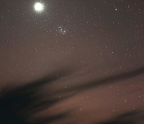Red light field test

Protection of the eyes’ dark adaptation is vital to visual astronomers. They share this need with aviators, mariners and military and security personnel. Even nocturnal pedestrians benefit from not being ‘night blind’. Yet while we have a decent understanding of how the eye recovers after it’s exposed to bright light, few researchers have investigated how exposure to faint light sources impairs vision, or which colour least interferes with dark adaptation at low levels.
Red has traditionally been the lighting colour of choice for visual astronomers, both for navigating safely around their environment and for reading charts. But there are no data to confirm that red is in fact the most appropriate colour for this purpose. When asked, astronomers will often (and incorrectly) state that the retinal receptors we use in dark conditions can’t detect red light, and therefore night vision is immune to red light. Probably another reason astronomers have used red light is its historic use in photography dark rooms. However, red lighting in dark rooms was not related to visual dark adaptation; rather, black-and-white photography paper was usually made red insensitive, so that developers could work in light that would not affect the paper instead of having to operate in total blackness.
You’re reading a preview, subscribe to read more.
Start your free 30 days



